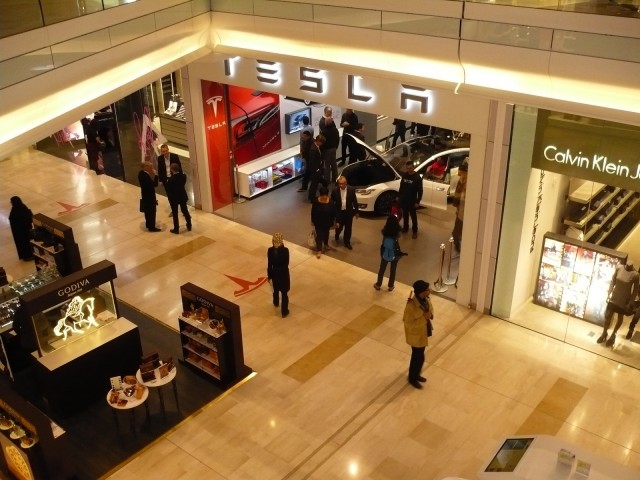Aside from both being premium brands and employees bouncing between the two companies, another thing Apple and Tesla have in common is a man called George Blankenship.
Blankenship was the brain behind Apple’s aggressive retail strategy during the early to mid 2000s, and he also spearheaded Tesla’s sales strategy in the early 2010s. His focus: get the brand into more malls.
As a result of this successful tactic, Tesla has now announced that it is opening 11 new sales outlets in the United States, all of which are in malls across California, New York, Texas, Florida, North Carolina and Delaware.
| Christiana, Newark DE |
| Coconut Point, Estero FL |
| Dallas Galleria, Dallas TX |
| Del Amo, Torrance, CA |
| Fashion Square, Sherman Oaks, CA |
| Florida Mall, Orlando FL |
| La Cantera, San Antonio TX |
| Roosevelt Field, Garden City NY |
| Roseville Galleria, Roseville, CA |
| Southpark, Charlotte NC |
| Victoria Gardens, Rancho Cucamonga, CA |
Now that Tesla is quickly clearing its reservation backlog for the Model 3, the company needs a solid strategy to continue evoking interest from mainstream car buyers.
The mall approach has certainly worked in its favor, and the EV maker is already doing better than Apple on a sales per square foot basis. Apple’s figure last year stood at $5,546. Although no numbers were released by Tesla, this is what Musk said at the time:
“I think our sales per square foot are so high, you need a telescope to see who’s in second place. It’s like stupidly high.”
To be fair, this is not a strategy adopted by traditional automakers. But Tesla is no traditional automaker. It is a pathbreaking brand just like Apple was in the late 2000s after the release of the first generation iPhone. And the Model 3 is obviously Tesla’s iPhone, but it still wouldn’t be an apples to apples comparison.
But the man behind it all – George Blankenship – can certainly take the credit for his work at Apple as well as Tesla, not to mention groundbreaking achievements during his tenure at Microsoft and GAP Inc.
More recently, Amazon had him on board as an independent consultant and, according to his LinkedIn profile, he is currently serving on the Board of Directors of LocalGravity AG, an information services company founded in 2012.
As for Tesla, its current retail strategy is obviously built on the foundation set up by Blankenship, and the company’s decision to rollout 11 more stores at malls is a sign that nothing much has changed direction-wise since Blankenship’s exit from Tesla at the end of 2013.
Why Malls, You Ask?
For one, this is where Tesla has tasted success. Its experiment with the Nordstrom store in LA at The Grove led to opening two more, in Michigan and North Carolina. It is also trying the same model in Australia. So something’s definitely working.
Second, Tesla is still in the brand-building stage.
Premium buyers are
The mall is where premium meets mainstream. Window shoppers are aplenty, but it’s also full of people with their credit cards hanging out of their pants. In other words, it’s a good place for Tesla to position itself during the critical transition from premium-only to a blend of premium and mainstream.
Third, malls help maintain that differentiating factor between Tesla and conventional automakers. It’s an image they won’t want to shed any time soon, and that’s clearly the direction they’re going in.
Fourth, now that Tesla is integrating power storage and solar energy products into its stores, the mall makes perfect sense for a combined experience for shoppers.
The fact that Tesla is betting all its sales chips on malls is further validated by the fact that it is slowly pulling out the retail parts of several stores, reserving them for its delivery and service needs, which are equally important as its on-road fleet keeps growing.
For now, its seems that Tesla has fully embraced Blankenship’s strategy and is pushing even harder to expand along those lines.



